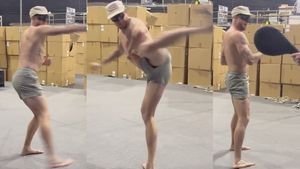
ONE National Gay & Lesbian Archives presents Joey Terrill: Just What Is It About Today’s Homos That Makes Them So Different, So Appealing?, a retrospective exhibition of work by Los Angeles-based queer Chicano artist Joey Terrill covering five decades of the artist’s work including paintings, drawings and artist publications.
Rooted in a commitment to social justice issues, Terrill’s work consists of categories of Chicano and queer art and identity, consistently blurring the line between art, life, archive and activism. The works assembled in this exhibition point to multiple concerns in the artist’s work such as raising queer and Chicana/o consciousness, complicating forms of representation and identity, and exploring personal histories.
Also on display is a selection of paintings from Terrill’s “Still Life” series that explores the artists’ ambivalence toward the pharmaceutical industry and the normalization of living with HIV/AIDS. Utilizing the language of 1960s pop art, Terrill’s studies place HIV drugs alongside mainstream consumer products depicted within a domestic space that hints at both Chicana/o and queer culture. Terrill’s paintings question the rapid cultural change found in both the LGBTQ community and wider public regarding HIV/AIDS. Today, life-saving pharmaceuticals are marketed like everyday consumer products, while the traumas and struggles of the early AIDS crisis are little acknowledged and public discourse around HIV/AIDS has largely decreased. Terrill’s paintings, rooted in autobiography, complicate our understanding of living with HIV. Additionally, the exhibition includes recent photorealistic paintings that replicate images from the artist’s personal archive and community-based projects such a Terrill’s illustrations in Chicos Modernos, a Spanish-language comic about safe-sex that was geared for toward young men and produced by the CORE Program in 1989.
The main exhibition includes Terrill’s seminal mail-art magazine Homeboy Beautiful (1978-79). Manipulating tropes of lifestyle magazines such as Ladies’ Home Journal and House Beautiful, Homeboy Beautiful satirized the straight, predominately white demographic of such publications, while using a queer sensibility to critique machismo in barrio culture. As Terrill explains the magazine’s premise:
"In both issues I played an undercover reporter named Santos who featured “exposes” of made up societal problems. In the first issue I exposed a secret underground network of ‘Homo-Homeboy’ parties where vato locos congregate late at night to drink, get high, and listen to Judy Garland records ending in a drunken orgy of sex and violence. The homeboys would remove their bandanas from their heads and strategically place them in either their ‘left’ or ‘right’ back pocket following the gay hanky codes of the 1970s. The sensibility [of Homeboy Beautiful] was more Dada and Mad Magazine in its approach then politically correct of strident."
For more information on this exhibition, please visit onearchives.org/joeyterrill.
Joey Terrill is organized by David Frantz, Curator at ONE National Gay & Lesbian Archives. Special thanks to scholar Robb Hernandez, USC Libraries, the City of West Hollywood, and especially the artist for his generosity and support of ONE.
Joey Terrill: Just What Is It About Today’s Homos That Makes Them So Different, So Appealing?
May 18 – August 25, 2013
ONE Archives Gallery & Museum
626 North Robertson Boulevard
West Hollywood, CA 90069

Joey Terrill
Homeboy Beautiful, Issue 1, 1978
Bound color magazine
Courtesy of the artist

Joey Terrill
Spread from Homeboy Beautiful, Issue 1, 1978
Bound color magazine
Courtesy of the artist

Joey Terrill
Detail from Homeboy Beautiful, Issue 1, 1978
Bound color magazine
Courtesy of the artist

Joey Terrill
Sabor A Mi, 1977
Mixed media on board, 16 x 11 inches
Courtesy of the artist

Group at the gay pride parade in West Hollywood wearing "Malfora" and "Maricón" t-shirts produced by Joey Terrill, c. 1976
Photograph by Joey Terrill
Courtesy of the artist

Joey Terrill’s studio, Los Angeles, c. 1979
Photo by Joey Terrill
Courtesy of the artist

Joey Terrill
He Wore Ray Ban Glasses, a Rolex Watch and He Used to Eat My Ass, 1985
From the series "Breaking Up/Breaking Down"
Acrylic on canvas, 16 x 20 inches
Courtesy of the artist

Trying to Sleep, 1985
From the series "Breaking Up/Breaking Down"
Acrylic on canvas, 16 x 20 inches
Courtesy of the artist

Joey Terrill
Still Life with Crixivan, 1997-98
Acrylic and mixed media on canvas, 36 x 48 inches
Courtesy of the artist

Joey Terrill
Still Life with Sustiva, 2000-01
Acrylic and mixed media on canvas, 36 x 48 inches
Courtesy of the artist

Joey Terrill
Chicos Modernos, Volume 2, 1989
Bound color magazine
Produced by the CORE Program, Los Angeles
Courtesy of the artist















































































